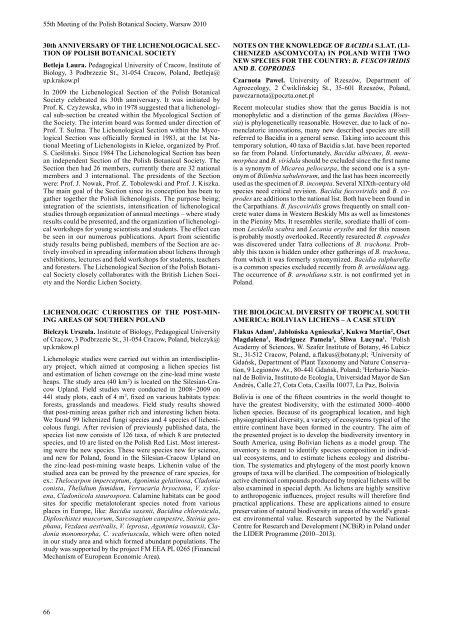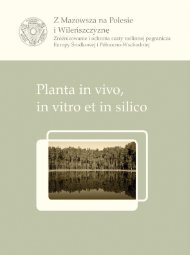acta societatis botanicorum poloniae - LV Zjazd Polskiego ...
acta societatis botanicorum poloniae - LV Zjazd Polskiego ...
acta societatis botanicorum poloniae - LV Zjazd Polskiego ...
Create successful ePaper yourself
Turn your PDF publications into a flip-book with our unique Google optimized e-Paper software.
55th Meeting of the Polish Botanical Society, Warsaw 2010<br />
30th ANNIVErSArY OF THE LICHENOLOGICAL SEC-<br />
TION OF POLISH BOTANICAL SOCIETY<br />
Betleja Laura. Pedagogical University of Cracow, Institute of<br />
Biology, 3 Podbrzezie St., 31-054 Cracow, Poland, lbetleja@<br />
up.krakow.pl<br />
In 2009 the Lichenological Section of the Polish Botanical<br />
Society celebrated its 30th anniversary. It was initiated by<br />
Prof. K. Czyżewska, who in 1978 suggested that a lichenological<br />
sub-section be created within the Mycological Section of<br />
the Society. The interim board was formed under direction of<br />
Prof. T. Sulma. The Lichenological Section within the Mycological<br />
Section was officially formed in 1983, at the 1st National<br />
Meeting of Lichenologists in Kielce, organized by Prof.<br />
S. Cieśliński. Since 1984 The Lichenological Section has been<br />
an independent Section of the Polish Botanical Society. The<br />
Section then had 26 members, currently there are 32 national<br />
members and 3 international. The presidents of the Section<br />
were: Prof. J. Nowak, Prof. Z. Tobolewski and Prof. J. Kiszka.<br />
The main goal of the Section since its conception has been to<br />
gather together the Polish lichenologists. The purpose being;<br />
integration of the scientists, intensification of lichenological<br />
studies through organization of annual meetings – where study<br />
results could be presented, and the organization of lichenological<br />
workshops for young scientists and students. The effect can<br />
be seen in our numerous publications. Apart from scientific<br />
study results being published, members of the Section are actively<br />
involved in spreading information about lichens through<br />
exhibitions, lectures and field workshops for students, teachers<br />
and foresters. The Lichenological Section of the Polish Botanical<br />
Society closely collaborates with the British Lichen Society<br />
and the Nordic Lichen Society.<br />
LICHENOLOGIC CUrIOSITIES OF THE POST-MIN-<br />
ING ArEAS OF SOUTHErN POLANd<br />
Bielczyk Urszula. Institute of Biology, Pedagogical University<br />
of Cracow, 3 Podbrzezie St., 31-054 Cracow, Poland, bielczyk@<br />
up.krakow.pl<br />
Lichenologic studies were carried out within an interdisciplinary<br />
project, which aimed at composing a lichen species list<br />
and estimation of lichen coverage on the zinc-lead mine waste<br />
heaps. The study area (40 km2 ) is located on the Silesian-Cracow<br />
Upland. Field studies were conducted in 2008– 2009 on<br />
441 study plots, each of 4 m2 , fixed on various habitats types:<br />
forests, grasslands and meadows. Field study results showed<br />
that post-mining areas gather rich and interesting lichen biota.<br />
We found 99 lichenized fungi species and 4 species of lichenicolous<br />
fungi. After revision of previously published data, the<br />
species list now consists of 126 taxa, of which 8 are protected<br />
species, and 10 are listed on the Polish Red List. Most interesting<br />
were the new species. These were species new for science,<br />
and new for Poland, found in the Silesian-Cracow Upland on<br />
the zinc-lead post-mining waste heaps. Lichenin value of the<br />
studied area can be proved by the presence of rare species, for<br />
ex.: Thelocarpon imperceptum, Agonimia gelatinosa, Cladonia<br />
conista, Thelidium fumidum, Verrucaria bryoctona, V. xyloxena,<br />
Cladoniicola staurospora. Calamine habitats can be good<br />
sites for specific metalotolerant species noted from various<br />
places in Europe, like: Bacidia saxenii, Bacidina chloroticula,<br />
Diploschistes muscorum, Sarcosagium campestre, Steinia geophana,<br />
Vezdaea aestivalis, V. leprosa, Agonimia vouauxii, Cladonia<br />
monomorpha, C. scabriuscula, which were often noted<br />
in our study area and which formed abundant populations. The<br />
study was supported by the project FM EEA PL 0265 (Financial<br />
Mechanism of European Economic Area).<br />
66<br />
NOTES ON THE KNOWLEdGE OF bAcidiA S.LAT. (LI-<br />
CHENIZEd ASCOMYCOTA) IN POLANd WITH TWO<br />
NEW SPECIES FOr THE COUNTrY: b. fuscoviridis<br />
ANd b. coProdes<br />
Czarnota Paweł. University of Rzeszów, Department of<br />
Agroecology, 2 Ćwiklińskiej St., 35-601 Rzeszów, Poland,<br />
pawczarnota@poczta.onet.pl<br />
Recent molecular studies show that the genus Bacidia is not<br />
monophyletic and a distinction of the genus Bacidina (Woessia)<br />
is phylogenetically reasonable. However, due to lack of nomenclatoric<br />
innovations, many new described species are still<br />
referred to Bacidia in a general sense. Taking into account this<br />
temporary solution, 40 taxa of Bacidia s.lat. have been reported<br />
so far from Poland. Unfortunately, Bacidia albicans, B. metamorphea<br />
and B. viridula should be excluded since the first name<br />
is a synonym of Micarea peliocarpa, the second one is a synonym<br />
of Bilimbia sabuletorum, and the last has been incorrectly<br />
used as the specimen of B. incompta. Several XIXth-century old<br />
species need critical revision. Bacidia fuscoviridis and B. coprodes<br />
are additions to the national list. Both have been found in<br />
the Carpathians. B. fuscoviridis grows frequently on small concrete<br />
water dams in Western Beskidy Mts as well as limestones<br />
in the Pieniny Mts. It resembles sterile, sorediate thalli of common<br />
Lecidella scabra and Lecania erysibe and for this reason<br />
is probably mostly overlooked. Recently resurected B. coprodes<br />
was discovered under Tatra collections of B. trachona. Probably<br />
this taxon is hidden under other gatherings of B. trachona,<br />
from which it was formerly synonymized. Bacidia sulphurella<br />
is a common species excluded recently from B. arnoldiana agg.<br />
The occurrence of B. arnoldiana s.str. is not confirmed yet in<br />
Poland.<br />
THE BIOLOGICAL dIVErSITY OF TrOPICAL SOUTH<br />
AMErICA: BOLIVIAN LICHENS – A CASE STUdY<br />
Flakus Adam 1 , Jabłońska Agnieszka 2 , Kukwa Martin 2 , Oset<br />
Magdalena 2 , rodriguez Pamela 3 , Śliwa Lucyna 1 . 1 Polish<br />
Academy of Sciences, W. Szafer Institute of Botany, 46 Lubicz<br />
St., 31-512 Cracow, Poland, a.flakus@botany.pl; 2 University of<br />
Gdańsk, Department of Plant Taxonomy and Nature Conservation,<br />
9 Legionów Av., 80-441 Gdańsk, Poland; 3 Herbario Nacional<br />
de Bolivia, Instituto de Ecología, Universidad Mayor de San<br />
Andrés, Calle 27, Cota Cota, Casilla 10077, La Paz, Bolivia<br />
Bolivia is one of the fifteen countries in the world thought to<br />
have the greatest biodiversity, with the estimated 3000– 4000<br />
lichen species. Because of its geographical location, and high<br />
physiographical diversity, a variety of ecosystems typical of the<br />
entire continent have been formed in the country. The aim of<br />
the presented project is to develop the biodiversity inventory in<br />
South America, using Bolivian lichens as a model group. The<br />
inventory is meant to identify species composition in individual<br />
ecosystems, and to estimate lichens ecology and distribution.<br />
The systematics and phylogeny of the most poorly known<br />
groups of taxa will be clarified. The composition of biologically<br />
active chemical compounds produced by tropical lichens will be<br />
also examined in special depth. As lichens are highly sensitive<br />
to anthropogenic influences, project results will therefore find<br />
practical applications. These are applications aimed to ensure<br />
preservation of natural biodiversity in areas of the world’s greatest<br />
environmental value. Research supported by the National<br />
Centre for Research and Development (NCBiR) in Poland under<br />
the LIDER Programme (2010– 2013).



